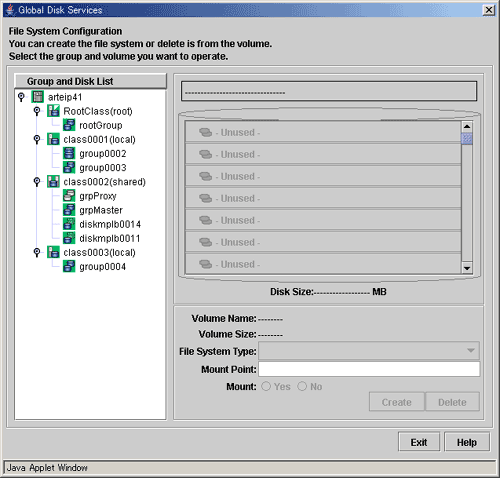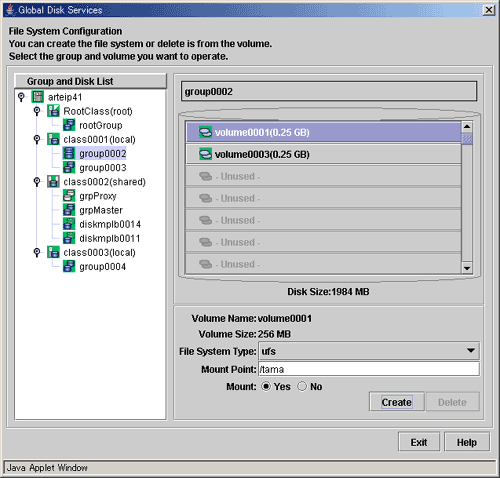In this section, how to create a file system (UFS) in a volume is explained.
If a volume has not started, start the volume and perform the following procedure.
In the [Settings] menu, select [File System Configuration]. File System Configuration screen appears.
Figure 5.36 File System Configuration

Selecting a group/disk
In the [Group and Disk List] field, select a group or disk with which you want to perform an operation.
Selecting a volume
Select a volume in which you want to create a file system.
Setting file system attributes
Selecting a volume will allow you to type in the file system attributes field (File System Type, Mount Point, Mount).
Figure 5.37 Setting File System Attributes

Setting [File System Type]
Select the file system type. You can select "ufs."
Setting [Mount Point]
Type the mount point you want to set for /etc/vfstab.
Setting [Mount]
Select "Yes" if you want to automatically mount when you start the volume, and "No" if not.
Selecting "Yes" will mount the file system to the specified mount point immediately after its creation.
However, you cannot select "Yes" when the volume in which you will create the file system exists on a shared disk unit.
Note
When Selecting "No" for "Mount"
When you select "No" for "Mount," [mount at boot] field in the /etc/vfstab file will be set to "No" and the new mount information will be added.
Change the mount information as necessary.
Creating the file system
After setting the attributes, click <Create>. A new file system will be created.
After creating all file systems, click <Exit>.
Note
In Cluster Systems
For using volumes on shared disks as file systems in a cluster system, certain settings are required after creating the file systems.
For details on how to set file systems created on shared disks, see "PRIMECLUSTER Installation and Administration Guide."
Note
Creating the UFS file system with less than 1 TB that can be expanded to 1 TB or larger
If you create the UFS file system with less than 1 TB in the File System Configuration screen, the size of the file system cannot be expanded to 1 TB or larger.
After creating the UFS file system with less than 1 TB, if you schedule to expand it to 1 TB or larger, create a file system with the newfs -T command of Solaris.
For details on the newfs(1M) command, see Solaris manual.